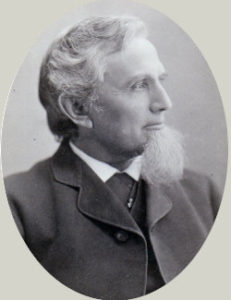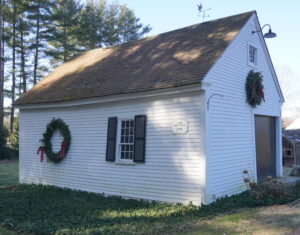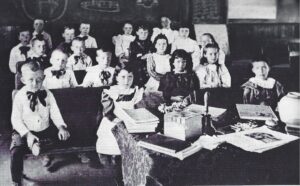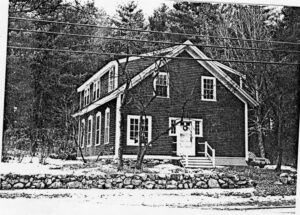Apr 1, 2024

From the earliest days, America’s Puritan settlers prioritized education. Parents were responsible for assuring their children could read (especially so they could read the Bible) and write, and all towns were required towns to set up schools. Boston Latin School was founded in 1635; Harvard in 1636. Dedham in 1644 authorized the first tax-funded public school, taught by Ralph Wheelock, whose salary was £20 per year. Wheelock founded Medfield in 1951 and was appointed schoolmaster here in 1655; the school was supported partly by taxes and partly by tuition.
For much of the 18th and 19th centuries there were schoolhouses in the center of town on Pleasant Street, on North Street near School Street, and on South Street, near High Street. There were two South schoolhouses, both of which survive. The older one (shown in the photo) was built about 1795 and was moved about 1855 to its present location, next to a handsome 1835 Greek Revival house at 205 South Street, where the old school is used as a garage. The other schoolhouse is now a private home at 15 High Street.
From a series of articles called Sixty Years Ago, written around the turn of the 20th century, Medfield historian William S. Tilden wrote in 1898 about the south schools and what life was like therein.
THE SOUTH SCHOOLHOUSE [circa 1840]
This was the institution of learning for the south part of the town, 60 years ago. It was removed to its present location in 1855 [and is still there].
The older part of this building was erected about 1796 and consisted of a single room, with a door opening directly to the outside world, a huge chimney and fireplace at one end and long benches for the children to sit on. Sometimes as many as 75 children, of ages from five to 20, were crowded in this room.
About 1831 it was enlarged by adding six feet for an entry and wood room. The chimney and fireplace were taken out and a very primitive stove put in to heat the building. The seats were remodeled so that two pupils were expected to sit at one desk, except in the short seats next to the wall, on each side. These seats and desks were made nicely, out of pine boards, by the town carpenter.
The master’s desk was built in the same fashion at one corner, high enough so that he could stand at it while writing, but also to give plenty of room for the close confinement of culprits underneath. The excellent cedar shingles with which the walls were covered in 1831, remain [but were replaced in the 20th century by clapboards].

Tilden also wrote a complementary article around the turn of the 20th century. It gives a good sense of what life was like in the 1840s, when he was a student in Medfield’s south school. The following originally appeared in Tilden’s exquisite handwriting, in a notebook he called Anecdotes and Incidents.
EXAMINATION DAY, IN THE SOUTH SCHOOL
The close of the winter school was always a great occasion in the South District. We had, in the old times, what was called the “winter school” and the “summer school.” In the summer we had a lady teacher, and only the little children went, – from about the middle of May till into July, – all who were big enough to be of any use at home on the farms being employed in that way, at that season of the year. The close of this school was not considered an event of any great consequence.
But the winter school, commencing the Monday after Thanksgiving, and continuing twelve weeks, was something to look forward to. We counted the days when it would be time for it to begin, and we dreaded the too rapid lapse of time which brought it to its end. For in the winter school the large boys and girls came, with their superior ways and more advanced studies; and then, too, we had a master, who could conduct affairs daily with a dignity calculated to win respect. For the more the children were bound to respect authority, the more enjoyment they obtained.

When the end of the winter school came, in its annual round, there was what we always called “examination day”; when the Committee of the town, the Prudential Committeeman of the District, and the parents and friends of the pupils came in a body to witness the final performances. These consisted of readings and declamations by those esteemed worthy, given with a greater or less degree of oratorical excellence, more frequently less, from the excitement of the occasion and great perturbation of spirits. There were some attempts at recitations of specially prepared things; but however carefully we had been “coached” beforehand, the answers given, owing to the influence of the surroundings, were sometimes unsatisfactory. Still, there were some pretty bright things done occasionally. At all events, if not, it was not due to external preparations for the great day.
On the afternoon preceding, school was dismissed for the purpose of giving opportunity for “cleaning the school-house.” In those days all such things were done by the pupils. The making of the morning fires, also; and the last thing before dismissing school every afternoon at four o’clock, was to appoint the boy who was to come early and make the fire next morning. At this closing time, the little ones, who would only be in the way, were ordered reluctantly home; and happy were those who were named to participate in “cleaning and trimming” the school-house.
Some brought soft soap; several boys ran to the sand pit for sand to scour with; some obtained from the neighbors mops and scouring rags. The larger boys put a big kettle of water on the stove, and lighted such a fire that they could scarcely get near enough to dip out the water when it was heated. Then the big girls, with rolled up sleeves, pitched into washing and scouring every pine-board seat and desk, the wainscoting around and finally the floor, till the whole place was redolent of soap-suds and the odor of wet wood.

Meanwhile a troop of boys dashed off like Indians to “pine-swamp,” half a mile away, for hemlock boughs and evergreens for trimming. Evergreen wreaths, mingled with bats of cotton, set off with cranberries, looked fine in conspicuous places. Sprays of hemlock made a capital to the projecting posts on the sides and in the corners of the room; then strings run diagonally from corner to corner, drooping somewhat gracefully toward the centre, over loaded from end to end with little twigs of hemlock. And so the preparations were completed.
In the forenoon of the day of days, those who lived far away came in the morning attired for the occasion: boys with their meetin’ pants and a collar, in addition to their usual habiliments, the girls with a different calico dress, and a different bow of ribbon, with long ends pinned to their hair. The poorer sort who had no bright dress, came with an old one, the colors pretty much discharged by many washings, indeed, yet looking very clean and wholesome for the day, provided no mishap befell during the scenes of the morning.
The school exercise for the forenoon were not important; brushing up on something which was to be displayed in the afternoon, or merely going over something already learned, in which the master was very smiling and indulgent, and everybody had a good time. At noon time the boys scattered over the entire neighborhood to borrow chairs for the company to sit in, which generally filled every inch of space not occupied by the school; some of the sturdy old farmers stood in the entry and looked in through the doorway.
The children who lived near came from home at noon, spick-and-span for the occasion. Some of the girls, whose parents could afford it, did not wear calico, but “delaine2“, as it was called in those times, and very bright ribbon in their hair. The boys wet down their head, and combed and brushed till they looked as “sleek as a mole.” The outside was all right, at any rate. Soon the master came in, dressed in his best satinet and laundered shirtfront, and the school were ordered to take their seats; where they sat in a highly expectant state, silent, but for an occasional whisper circling round, waiting for the guests to arrive, and until they were judiciously seated.
When it was deemed that the proper time had come the exercises began: feebly at first, with some of the younger children gradually expanding, til the event wound up with startling mathematical demonstrations at the blackboard, and the rendering of something from Daniel Webster or Shakespeare.
At the conclusion of our cut-and-dried performances, which were, by an accommodation of speech, called “the examination,” the chairman of the town committee addressed the school. We can well remember Dr. Sanders, D.W. Phillips, T.T. Richmond, Charles Robinson, and Jonathan P. Bishop, taking this part. The town committee, in those days, was made up of the professional men of the place. Their addresses were generally complimentary, and were packed full of what nobody ever heeds at the time, viz. – good advice. Much sound sense and salutary warning was poured into our impatient ears at such times.
Then school was dismissed; the visitors departed; the boys carried home the chairs they had borrowed; all the pupils gathered together their books, slates, writing-books, spare quills, and inkstands, and left for home. School was finished.
_____
2 A high-grade worsted dress goods formerly in use.